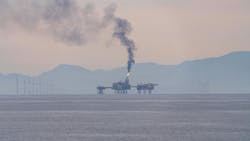Opinion: Electrification, digitalization and carbon capture reshaping the North Sea's future
Key Highlights
- The North Sea sector has already reduced production emissions by 34% and methane leaks by 53%, surpassing some targets ahead of schedule.
- Electrification of offshore platforms using renewable energy sources like wind can cut emissions by up to 85%, but challenges such as infrastructure retrofitting and grid delays remain significant hurdles.
- Carbon capture and storage offers a promising pathway for decarbonizing the sector, with existing infrastructure ready for repurposing to store CO2 and support heavy industries.
By Niki Chambers, Net Zero Technology Centre
The last barrels of oil must be the cleanest, and the North Sea’s oil and gas sector must prove it can deliver. Anything less risks forfeiting public trust and political support.
The Climate Change Committee’s (CCC) latest progress report is blunt. Continued reliance on fossil fuels will undermine energy security, inflate household bills and delay the shift to cleaner systems. The message is unequivocal: slash production emissions, scale up transition technologies and avoid locking society into new high-carbon investments.
At first glance, the prescription looks impossible. Yet the North Sea’s record suggests otherwise. According to the North Sea Transition Authority, operators cut production emissions by 34%, already beating the 2027 target. Methane releases, a potent climate culprit, are down 53%, already surpassing the 2030 milestone. These achievements reflect regulatory pressure and a clear willingness from the industry to lead on emissions reduction, demonstrated by rapid adoption of new monitoring technologies, investment in flare-gas recovery and a collaborative approach to meeting and exceeding targets.
Flaring and venting
Offshore flaring has halved, thanks to tighter regulation and flare-gas recovery units that turn waste into usable fuel. These are genuine achievements, but the harder half still lies ahead. The CCC says emissions must halve again by 2030 and fall 90% by 2040 if net zero is to remain in reach.
Offshore operations are carbon-intensive, remote and reliant on old infrastructure. Power from gas turbines or diesel generators accounts for nearly 80% of upstream emissions, with flaring and venting contributing most of the rest. The task is clear: decarbonize power, eliminate waste and future-proof assets so they can support a lower-carbon system.
Electrification
Electrification of platforms remains the single biggest lever for reducing emissions. Replacing gas turbines with renewable power from shore or offshore wind can cut combustion-related emissions by up to 85%. Projects across the UK Continental Shelf are actively exploring how to rewire mature installations, with subsea HVDC cables to onshore grids or offshore wind farms offering the potential to transform emissions profiles.
However, the challenges are significant, including distance from shore, the complexity of retrofitting older assets and intermittency in renewable supply. Grid delays add to the bottlenecks, but coordinated investment can address them. Norway’s Hywind Tampen project, using floating wind to power platforms, shows what is possible, and similar concepts are now being studied in UK waters.
The industry recognizes that electrification will not be feasible for every asset, especially in the near term. This is why operators are also proactively pursuing “Plan B” options such as integrating alternative fuels (e.g., methanol, ammonia, bio/e-diesel), deploying small-scale renewables and adopting hybrid power systems.
Digitalization
The sector’s openness to innovation is evident in the widespread deployment of digital twins, AI-driven analytics and predictive maintenance, tools that many North Sea operators have embraced to drive both emissions and cost reductions. The combined effect is fewer vessel trips, less flaring during interventions and a more efficient offshore system.
The North Sea’s success in reducing methane is further poof of their willingness to adapt and innovate. Today, technologies make it possible to spot and stop leaks in near real time. Autonomous drones and fixed sensors equipped with infrared cameras can detect methane plumes in hours compared with weeks for manual surveys.
CCS
Carbon capture could be the next frontier. Depleted reservoirs and saline aquifers in the North Sea offer one of the highest potential CO2 storage capacities globally, with existing pipelines and subsea infrastructure ready to be repurposed. Carbon capture and storage (CCS) offers a pathway to decarbonize oil and gas and to serve heavy industries, locking away millions of tonnes of CO2 under the seabed each year, with existing pipelines and subsea infrastructure ready to be repurposed.
While CCS provides a vital backstop, NZTC’s latest alternative fuels report urges a shift in thinking: incentivizing carbon utilization over storage, so captured biogenic CO2 is channeled into fuel production. Only 2 million tonnes of biogenic CO2 are currently captured worldwide each year, highlighting the need to maximize the value of every tonne. By integrating CO2 utilization with hydrogen, the North Sea can become a hub for producing low-carbon fuels, supporting both emissions reduction and energy security.
Offshore hydrogen and alternative fuels
The future offshore system will not stop at storing and using carbon. Offshore hydrogen production, powered by floating wind farms, could unlock new synergies. Crucially, hydrogen’s greatest impact may be as a precursor for alternative fuels. NZTC’s alternative fuels report demonstrates that combining green hydrogen with captured CO2 enables the production of sustainable fuels like SAF, e-methanol and e-ammonia, which are fuels that are vital for decarbonizing the aviation, shipping and heavy industries. This approach not only advances decarbonization but also creates new value streams for the North Sea’s existing infrastructure.
Hydrogen’s role as a feedstock for alternative fuels is central to the UK’s net-zero ambitions, as highlighted by government mandates for SAF and maritime decarbonization. Yet the technology faces hurdles. Electrolyzers must prove durable offshore and hydrogen costs remain high. Scaling this vision will require breakthroughs in durability and efficiency as well as billions in capital. The UK is well placed to lead, combining offshore expertise, supply chains and abundant wind. The same subsea skills that once enabled deepwater oil fields can now accelerate offshore hydrogen hubs.
Policy and investment frameworks
Technology alone will not deliver the cleanest barrel. Policy and investment frameworks must reinforce ambition. New environmental impact assessment guidance now requires developers to account for downstream or Scope 3 emissions. In practice, that moves climate risk onto company balance sheets.
Large-scale projects seeking consent must show electrification-ready designs, CCS integration or hydrogen compatibility. Without that, capital will be harder to raise and permits harder to secure. Investors, too, are tilting the balance. Lower cost of capital is flowing to assets with demonstrably lower emissions.
The willingness and interest from the industry to make a difference is already evident. What’s needed now is continued support, clear policy signals and investment to match the sector’s ambition. Operators should publish robust action plans within 18 months, design all post-2026 projects for zero routine flaring and ringfence R&D budgets for low-carbon technology. The government should accelerate CCS licensing, fast-track grid connections for electrification and align methane standards with UK Emissions Trading Scheme pricing.
Key takeaway
The North Sea was built on engineering audacity, from horizontal drilling to subsea robotics to floating production and storage units. Delivering the cleanest barrels is the next chapter in that story. By cutting emissions ruthlessly, capturing carbon at scale and competing in hydrogen, the sector can turn a climate ultimatum into a springboard for renewal. What works here can set standards for offshore basins worldwide.
The choice is stark: evolve or fall behind. If the industry gets this right, it can secure affordable, low-carbon energy for every UK household and sustain a world-class offshore supply chain for decades to come.
About the Author

Niki Chambers
Niki Chambers is head of technology solutions at the Net Zero Technology Centre (NZTC). With more than 30 years’ experience in subsea engineering, flow assurance and technology development, she has held senior technical and leadership roles across the offshore sector. At NZTC she leads work on foresight and joint industry projects that advance decarbonization and net-zero goals.


